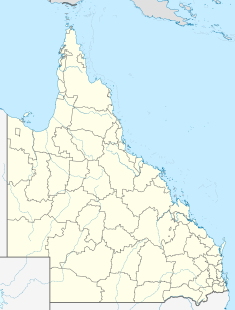Toowoomba Hospital
| Toowoomba Hospital | |
|---|---|
 |
|
| Location | Pechey Street, Toowoomba, Toowoomba Region, Queensland, Australia |
| Coordinates | 27°34′11″S 151°56′34″E / 27.5697°S 151.9429°ECoordinates: 27°34′11″S 151°56′34″E / 27.5697°S 151.9429°E |
| Design period | 1870s - 1890s (late 19th century) |
| Built | c. 1880 - c. 1927 |
| Official name: Toowoomba Hospital, Toowoomba Base Hospital | |
| Type | state heritage (built) |
| Designated | 28 July 2000 |
| Reference no. | 601296 |
| Significant period | 1880s-1920s (fabric) 1880s-1940s (historical, social) |
| Significant components | fence/wall - perimeter, mortuary, pipeline - steam, ward - open air, gate - entrance, kitchen/kitchen house, trees/plantings, residential accommodation - quarters |
Toowoomba Hospital is a heritage-listed hospital at Pechey Street, Toowoomba, Toowoomba Region, Queensland, Australia. It was built from c. 1880 to c. 1927. It is also known as Toowoomba Base Hospital. It was added to the Queensland Heritage Register on 28 July 2000.
The Toowoomba General Hospital was established on its present James Street site in 1880 as the third site of a public hospital in the city and its second permanent home. The Hospital has been altered since its establishment with major phases of development in the 1890s-1910s; 1950s-1960s and more recently in the late 1990s. Two buildings remain extant from the 19th century and several remain from the early part of this century. It is these earlier buildings that comprise the focus of this report.
Early public hospitals were established for the provision of health care services for those people who could not afford private medical attention in their homes or in private institutions. Nineteenth-century Queensland hospitals were established by local voluntary hospital committees, which usually experienced some difficulty raising funds for both the establishment and running of the hospitals. Government grants were commonly available for the construction of hospital buildings. It was not until the Hospitals Act of 1923 that hospitals and public health became basic responsibilities of the government, resulting in the creation of hospital boards throughout the state who assumed control of local hospitals. Toowoomba Hospital was established during the voluntary committee period and was taken over by the Hospital Board following the introduction of the 1923 Act. From that time, development of the site was largely controlled by the Board.
The idea of erecting a hospital in Toowoomba was discussed with the very early services to be provided in the town - reflecting the importance of a local health service for the early town. Discussions began in 1856 in the nearby town of Drayton which was soon overshadowed in development by the more dramatic growth of Toowoomba and therefore, by June 1859 a small house was rented in Russell Street for the purpose of providing hospital services. By 1864 a timber hospital was constructed at the corner of James and Ruthven Street on land granted by the Colonial Government. This building was destroyed by fire on 25 December 1867, and plans for a brick building on the same site were drawn up by Richard George Suter, a Brisbane architect influential in hospital design in the late 1860s. Suter was an advocate for hospitals based on the pavilion plan principle, which maximized light and ventilation to all patients, and this early Toowoomba hospital was one of the first examples of this principle, which was to remain current for the design of hospital buildings through to the 1930s.
...
Wikipedia


